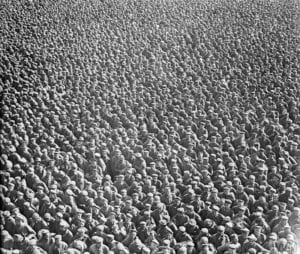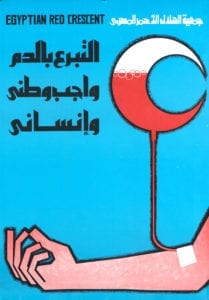Chris Arthur
St. Andrews, Scotland

Henri Dunant (1828–1910), Swiss philanthropist and “father of the Red Cross.” Source
Two photographs in Dunant’s Dream, Caroline Moorehead’s meticulous and moving history of the Red Cross, can be juxtaposed to illustrate a key aspect of this organization’s work.
The first shows Henri Dunant, now regarded as “the father of the Red Cross.”1 In June 1859, this thirty-one-year-old businessman was traveling in Italy when he witnessed the aftermath of a battle between Franco-Italian and Austrian armies at the small town of Solferino. This harrowing event became the defining experience of his life.
In A Memory of Solferino Dunant gave a shocking description of what he had seen:
Bodies of men and horses covered the battlefield: corpses were strewn over roads, ditches, ravines, thickets and fields; the approaches to Solferino were literally thick with dead . . . The poor wounded men were ghostly pale and exhausted. Some, who had been most badly hurt, had a stupefied look. Others were anxious and excited by nervous strain and shaken by spasmodic trembling. Some, who had gaping wounds already beginning to show infection were almost crazed with suffering. They begged to be put out of their misery.2
Moved to pity, Dunant organized a group of local people to help him take food and water to the injured, tend their wounds, and do what they could to comfort the dying. This practical, hands-on aid was the seed from which the Red Cross grew.
When A Memory of Solferino was published it touched a nerve. It was “greeted everywhere with admiration, horror and guilt.”3 Among the many plaudits was Victor Hugo’s comment to Dunant that by writing his book he had performed “a great deed for humanity.”4 Just how great a deed it was would only become evident as Dunant’s dream of setting up an organization to provide care for the casualties of war developed into the reality we know today—the Red Cross Red Crescent Movement, a humanitarian colossus comprising 186 National Societies with millions of members worldwide. It is “a movement which has no equal in size and commitment outside of organized religion.”5
* * *

The second photograph shows German prisoners-of-war at a clearing depot in Abbeville in 1918. The men are packed so closely together, and there are so many of them, that it is hard to make out what the photo shows. It would be easy to dismiss it as an abstract pattern, or to think that it is a study of some feature of the landscape, perhaps an aerial view of a massive field of stones. It takes the mind a moment to register the fact that this is a multitude of people drawn together in overwhelming numbers. In such a setting, individuals vanish into anonymity. The plight of one person might move us. En masse, people’s needs often blur into something impersonal and seemingly of no concern to us. Faced with a crowd, we tend to forget about the individuals who make it up. The Red Cross does not. Attending to the needs of those in distress—whether POWs, victims of drought, flood, earthquake, or some other calamity—the Red Cross treats everyone as an individual, as if they matter.
* * *
Putting these two photographs side by side—so that a single named person and an anonymous crowd are held in the same conceptual breath—flags up the way in which the Red Cross works. Throughout its history we see handfuls of committed, compassionate, and courageous individuals helping to alleviate the suffering of hundreds, thousands, even millions of their fellows. In his actions at Solferino—where he and a few local recruits tended a whole battlefield of casualties—Dunant set in place a dynamic that was to characterize the work of the organization founded on his vision.
Pairing Henri Dunant with the crowded POWs symbolizes this recurrent theme in Red Cross history. But they are by no means the only images I could have used. The POWs at Abbeville could be replaced with pictures from the Rwandan genocide, or from conflicts in Bosnia, Somalia, or Iraq, or those showing the devastating impact of natural disasters—whether earthquakes, hurricanes, or famine. In each case multitudes are left in desperate need. Instead of Dunant, we could picture any of the Red Cross doctors, nurses, or non-medical personnel who have played a key role in the movement’s humanitarian aid programs. We might choose Frédéric Maurice, a delegate from the International Committee in Geneva, who was killed in the course of his duties in Sarajevo in 1992; or the formidable Mabel Boardman, who did so much to shape the early history of the American Red Cross; or Anisa, a Red Crescent volunteer in Afghanistan whose bravery in caring for patients, even when Taliban fighters took over the hospital she was working in, led to the award of the Florence Nightingale Medal. However the dynamic of the few caring for the many is pictured, help is always given under the Red Cross’s seven guiding principles. These act as a kind of institutional Hippocratic oath, ensuring that its neutrality is unimpeachable and its help extended to anyone in need, regardless of their circumstances.6
* * *

Red is “the boldest of all colors,”7 it is “the first color of the newly born and the last seen on the deathbed.”8 It is a color that encompasses “everything from sunsets to the roseate tint of our insides.”9 The fact that red, with all its potent connotations, is the emblematic color of the Red Cross is highly apposite. In particular, it conveys more powerfully than words the close connection between the organization and blood. Often its work is prompted by bloodshed—whether at Solferino or in contemporary battle zones. Tending casualties involves the staunching of wounds and the replenishment of lifeblood. Many national Red Cross societies have organized blood donations. For example, during World War II, the American Red Cross “collected over 13 million units of blood, and blood taken from a donor on the Atlantic Seaboard could be in the veins of a wounded soldier the next day.”10
But the symbolic payload of the organization’s familiar blood-red logo goes much deeper than such obvious associations. Given its commitment to saving lives, to alleviating suffering, it is fitting that the Red Cross is so closely associated with the liquid on which our lives depend. Second by second we all rely on our inner red sea following the tides determined by the heart’s metronome. “The average human has about five trillion red blood cells per litre of blood, or thirty trillion in total.”11 Without the precious cargo of oxygen carried by these cells, we cannot survive. Every day these thirty trillion cells “do a full circuit of the body, travelling about twelve thousand miles” 12 through its labyrinth of veins and arteries and capillaries.
Look at the photograph of Henri Dunant and the massed ranks of anonymous POWs, look at any of the other paired images I have suggested. Everyone pictured is, or was, dependent on the exquisitely balanced intricacies of blood circulating at about “two to three miles an hour”13 around the complex mortal conduits of their bodies. We all rely on blood continuing to flow safely within us. We all bleed the same red when injured. What better color for the Red Cross to stand by, work under, than that which animates all of us? But history too often shows us forgetful of our essential consanguinity. We spill each other’s blood with distressing readiness and ignore those in need. The Red Cross acts as a compassionate counterweight to our inhumanity. In its philosophy and actions it provides a kind of a blood mnemonics, reminding us that “in the red stuff that courses through our veins and arteries, we are one and the same,”14 each with the same fundamental vulnerabilities and needs; each deserving of the same care.
This close relationship between the Red Cross and blood is summed up well in a poster featured in a recent exhibition at the Red Cross Museum in Geneva. Produced by the Egyptian national society, it shows a red crescent attached by a line to an outstretched arm. Blood is flowing from the crescent into a vein. Here is a vivid pictorial summary of what the Red Cross does. The organization provides succour, to anyone who needs it—whether this takes the form of actual blood, or food, clean water, shelter, education, medicine, information about the missing, or any of the other measures the Red Cross offers those in need. Keeping the image in mind is a good way of remembering our common, blood-dependent humanity and the movement that has done, and that continues to do, so much to protect it.
References
- Henri Dunant, A Memory of Solferino (Geneva: International Committee of the Red Cross, 1959), 7.
- Ibid., 41 & 48. Dunant’s book was first published in 1862. It’s available for free download in a variety of languages from the ICRC. See: https://shop.icrc.org/un-souvenir-de-solferino-2551.html.
- Caroline Moorehead, Dunant’s Dream: War, Switzerland and the History of the Red Cross (London: HarperCollins, 1998), 8.
- Ibid., 9.
- Ibid., 716.
- The seven guiding principles are: humanity, impartiality, neutrality, independence, voluntary service, unity, and universality. All Red Cross and Red Crescent activities have one fundamental purpose: to help without discrimination those who suffer.
- Alexander Theroux, The Primary Colors (London: Macmillan, 1996), 153.
- Ibid.
- Ibid., 258.
- Rose George, Nine Pints: a Journey Through the Mysterious, Miraculous World of Blood (London: Granta Books, 2019), 274.
- Chris Cooper, Blood, a Very Short Introduction (Oxford: Oxford University Press, 2016), 21.
- George, op.cit., 6.
- Ibid., 1.
- Lawrence Hill, Blood: a Biography of the Stuff of Life (London: Oneworld, 2014), 252.
CHRIS ARTHUR, PHD, is an Irish writer based in Scotland. His most recent book is Hummingbirds Between the Pages (2018). His work has been included in The Best American Essays and is frequently mentioned in the “Notable Essays” lists of this annual series.
Submitted for the 2019–2020 Blood Writing Contest

Leave a Reply